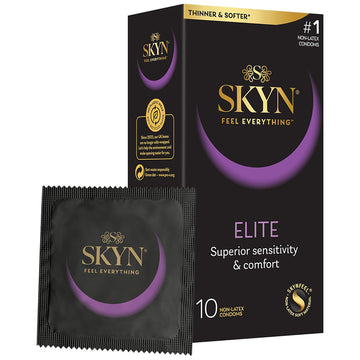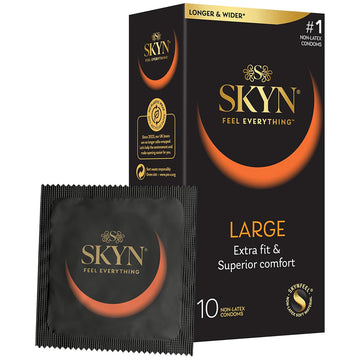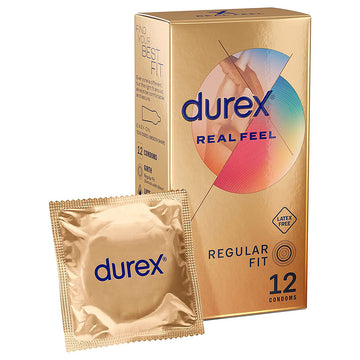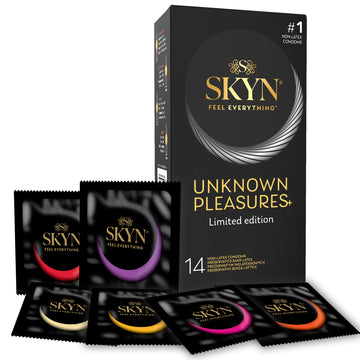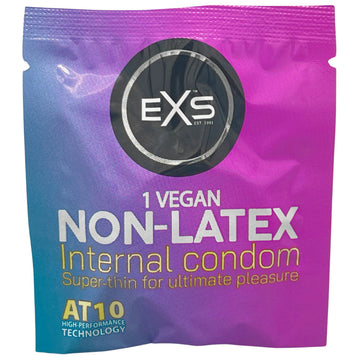What are non-latex condoms?
Non-latex condoms are condoms made from other natural (lambskin) or synthetic (plastic) materials. These condoms are mainly designed for people with latex allergies, but they can be used by anyone who wants a thinner condom that can deliver more natural sensations.
According to a study published in the Journal of Occupational Health, scientists revealed that latex allergies affect almost 5 per cent of the general population and nearly 10 per cent of healthcare workers.
All these people can’t use natural rubber latex condoms to protect themselves from sexually transmitted infections and to prevent pregnancy. Luckily, most non-latex condoms on the market are made of modern materials that deliver the same resistance as latex condoms without the side effects.
Types of non-latex condoms
Non-latex condoms can be divided into two main categories, synthetic non-latex condoms and natural non-latex condoms.
Polyurethane condoms
Made of plastic, polyurethane condoms are as effective as natural latex condoms against pregnancy and sexually transmitted infections. They come in both male and female condom varieties, so you have options if you are looking for a condom that goes inside the vagina rather than on your penis.
Polyurethane condoms are popular for their thin walls that conduct heat well and deliver an almost skin-on-skin feel. However, polyurethane isn’t as stretchy and elastic as natural latex, so a polyurethane condom might not fit as well.
The main risk with polyurethane condoms is that they might slip off or break during intercourse. On the bright side, polyurethane condoms from brands like Pasante are compatible with almost all lubricants, including oil and petroleum jelly alongside the usual water-based and silicone-based lubes.
What are the advantages of polyurethane condoms?
- Polyurethane condoms conduct heat better: Compared to latex and polyisoprene condoms, polyurethane condoms are better heat conductors. This translates into more natural sensations and a greater sense of intimacy.
- Polyurethane is thinner than latex and polyisoprene: A thinner condom can also increase the sense of intimacy.
- Polyurethane condoms are not constrictive: If you like a looser fit, polyurethane condoms could be more suitable for you even if you’re not allergic to latex. This material is not as elastic as latex or polyurethane, so the condoms aren’t as tight.
What are the disadvantages of polyurethane condoms?
- Polyurethane condoms are the least elastic and more likely to break compared to polyisoprene or latex condoms. For this reason, it is crucial to size them right.
- Because polyurethane condoms don’t fit as snugly as latex or synthetic latex condoms, they are more likely to slip off during intercourse.
-
Polyurethane is a type of plastic similar to cling wrap, and has a similar feel. This material conducts heat better and is very thin, but it has a synthetic feel. The sensation of these non latex condoms is similar to using a tight female condom.
What brands make polyurethane condoms?
Most brands nowadays make their latex free condoms from polyisoprene or synthetic resin. However, Trojan’s Supra condoms are made of polyurethane. Trojan's Supra condoms are very thin (0.047mm), but their nominal width of 58mm makes them suitable for men who need a large condom. If you normally wear a regular size condom, there is a high risk they’ll slip off during intercourse.
Polyisoprene condoms
Like polyurethane condoms, these condoms are made of plastic. However, the newer technology ensures higher elasticity and resilience. This type of synthetic rubber conducts heat better than latex and is much thinner. It delivers an almost natural feel and also stretches better than polyurethane, so you won’t have to worry about the condom fitting awkwardly or uncomfortably on your shaft.
Like latex condoms, polyisoprene condoms are compatible with water-based and silicone-based lubes, but oils and petroleum jelly could damage them. Most brands making non-latex condoms, including SKYN and Durex, are now using polyisoprene instead of polyurethane in their condoms.
What are the advantages of polyisoprene condoms?
- Polyisoprene condoms are as effective as latex condoms:
Polyisoprene is the only non-latex material that is as effective as latex. With perfect use, this particular type of latex free condom is 98% effective in preventing pregnancy and sexually transmitting infections. As it happens with latex condoms, their effectiveness drops with normal use, mainly because few people follow all instructions on the packet.
- Polyisoprene is more elastic than latex:
These latex free condoms stretch easier than latex condoms and are more resistant. Thanks to this characteristic, most polyisoprene condoms are thinner than 0.06mm, which is the average thickness of latex condoms.
- Polyisoprene is tasteless and odourless:
Many latex condom brands advertise their condoms as odourless and tasteless, but the truth is that latex has a characteristic smell and taste – smell and taste that many people don’t like. You won’t have the same issue with polyisoprene condoms. Despite being basically latex made in a laboratory, polyisoprene has a neutral scent and no taste at all.
- Polyisoprene condoms are clearer than latex condoms: Tired of the yellowish shade? Polyisoprene condoms are more transparent.
- Polyisoprene condoms are cheaper than polyurethane condoms: All condoms are affordable, but if you want a superior product and a few extra quid in your pocket, polyisoprene condoms are the way to go.
What are the disadvantages of polyisoprene condoms?
- Polyisoprene condoms are incompatible with oils and petroleum-based products. Like latex, polyisoprene can be damaged by Vaseline, body creams and lotions, massage oils. You should only use these non latex condoms with condom-friendly lube.
What brands make polyisoprene condoms?
SKYN is the most popular brand of polyisoprene condoms. Striving to cater to everyone’s needs,
SKYN latex free condoms come in multiple sizes and types.
The brand’s regular size has a nominal width of 53mm and 180mm of length. In this category, you can find SKYN Original condoms, SKYN Elite condoms, which are ultra thin; as well as SKYN Ribbed and Dotted condoms. A large size condom with a nominal width of 56mm and a length of 200mm is also available from the brand.
Durex is another brand that makes polyisoprene, latex-free condoms. However, the choices are limited. Durex Real Feel condoms have a nominal width of 56mm and are 205mm long.
Synthetic resin condoms
Synthetic resin is a rather innovative non-latex material used by few brands. The official name of this material is AT-10, and its main advantage is that it has higher strength in thinner sheets than other materials, including polyisoprene, polyurethane, and latex. The material is not stretchable, but it has the ability to cling to the skin in a way similar to polyurethane.
What are the advantages of synthetic resin condoms?
- Synthetic resin condoms are incredibly thin: The AT-10 sheets have a thickness between 0.015mm and 0.030mm – the thinnest synthetic material used for condoms.
- AT-10 is not porous: This material provides the same protection against pregnancy and sexually transmitted infections as polyisoprene and polyurethane condoms. With perfect use, these condoms are 98% effective.
- AT-10 does not degrade when exposed to common oils: These condoms can usually be used with oil-based lubricants. However, remember to always follow the manufacturer’s instructions when choosing an appropriate lube.
- AT-10 allows the body heat to pass through quickly: Like polyurethane condoms, AT-10 condoms are excellent heat conductors and can enhance the feel of intimacy.
What are the disadvantages of synthetic resin condoms?
- Synthetic resin condoms have a poor elasticity and can slip off easier during intercourse.
- Like polyurethane condoms, AT-10 condoms feel like cling wrap on the skin. Some people like how they feel – the only way to tell is trying them.
What brands make synthetic resin condoms?
Pasante is one of the few brands that make synthetic resin condoms. You can pick from a thicker (and smaller) version, as well as a thinner and larger one.
Pasante Sensiva condoms have a nominal width of 58mm and are 180mm long. At 0.028mm thick, these condoms are on the thicker side as far as synthetic resin condoms are concerned. They’re obviously thinner than all other types of condoms. A nice touch is the condom placement in an easy-to-open round pot that minimises the risk of damaging the condom when taking it out of its packet. Pasante Sensiva condoms can be used with all types of personal lubricants and massage oils, as well as silicone or water-based lube.
Pasante Unique condoms are larger and thinner than Sensiva. They have a nominal width of 60mm, a length of 190mm, and are 0.015mm thick. These condoms are resilient and extremely flexible, feeling like nothing at all between you and your partner. Pasante Unique condoms can also be used with all types of intimate lubricant, including oil products. Both AT-10 condoms from Pasante are cruelty-free and vegan friendly.
Lambskin condoms
The only natural alternative to latex condoms, lambskin condoms have been around for centuries, long before the latex variety. Whilst they provide the most natural feel, they are not as effective as latex condoms against pregnancy and sexually transmitted infections.
Nowadays, lambskin condoms are sparsely used in some parts of the USA and Australia, but they cannot be sold in the UK and Europe.
What are the advantages of lambskin condoms?
- Lambskin condoms are as effective as latex condoms in preventing pregnancy: If your main concern is preventing pregnancy, lambskin condoms are 98% effective.
- Lambskin condoms are very comfortable:
From all condom types, lambskin condoms are the most comfortable. Because the material is natural, lambskin condoms provide the most natural feel and an unrivalled sense of intimacy.
- Lambskin condoms can be used with all lubes: Like AT-10, lambskin isn’t degraded by oils or Vaseline. You can use lambskin condoms with any type of lube.
- Lambskin condoms suit large sizes: These condoms are often larger than their latex or polyisoprene counterpart.
- Lambskin condoms are biodegradable: Made of sheep’s intestine, these condoms degrade faster than all others. However, you should still throw them in the bin.
What are the disadvantages of lambskin condoms?
- Lambskin condoms don’t protect against sexually transmitted infections. The porous material may allow viruses and bacteria to pass through, so it’s recommended to use them only if you’re in a committed, monogamous relationship or with partners that have been tested for STIs.
- Lambskin condoms are less attractive than other condoms. You’ll usually be able to see the details of the sheep’s intestine on the condom.
- Natural lambskin condoms are not as stretchy as latex or polyisoprene condoms. Similar to polyurethane and AT-10 condoms, lambskin condoms are more likely to slip off during use.
- Lambskin condoms are the most expensive type of condoms. Because they are an animal product, they can’t be mass-produced in the same way the other types of condoms are, so lambskin condoms may not be as readily available as other types of condoms either.
What brands make lambskin condoms?
Trojan Naturalamb is one of the few lambskin condoms available. These condoms have an extra-large size (68mm nominal width) and feature a rounded head with no teat end. This design improves comfort, but could make it challenging to prevent leaks after ejaculation. Nevertheless, these are some of the most comfortable condoms you can find.
Advantages of non-latex condoms
Non-latex condoms are majorly used by people with a latex allergy, but they come with advantages that could make them a suitable option even if you’re not allergic to latex. Here are some of their most common pros:
- Both polyurethane and polyisoprene condoms conduct heat better, allowing for a more natural feel for both partners
- Non-latex condoms are thinner than latex condoms but provide similar strength
- Polyurethane condoms can be used with all kinds of intimate lube
- Non-latex condoms have a neutral flavour and odour and you won’t be disturbed by the latex taste or smell
Potential downsides of non-latex condoms
Like everything else, not all is nice and shiny when it comes to non-latex condoms. Depending on the material, they may also have some downsides.
- Polyurethane condoms aren’t as stretchy as latex and they are more likely to break or slip off during sex
- The manufacturing process of non-latex condoms is more complex. Thus, these condoms are often more expensive than their latex counterpart
How come non-latex condoms are thinner than latex condoms?
It all comes down to the manufacturing process and properties of each material. Plastic materials including polyurethane and polyisoprene provide the same resistance as latex condoms even if they have thinner walls.
Whilst thick non-latex condoms exist, most people prefer non-latex condoms precisely because of their thin walls designed to enhance sensations. Plastic also conducts heat better than latex, making you feel closer to your partner.
To understand the thickness difference between latex and non-latex condoms, you should know that the thinnest latex condoms are rarely thinner than 0.045mm, whilst thin non-latex condoms can have walls as thin as 0.020mm or even thinner.
Why are most condoms made of latex if the material may cause allergies?
Manufacturers prefer using latex instead of non-latex materials due to the material’s resistance and costs.
Latex condoms were invented in the 1920s and are made from natural rubber, a substance that is harvested from trees and is rather inexpensive. Over the decades, the manufacturing process has also been optimised, and nowadays, making latex condoms is cheap.
Despite its low cost, latex is a highly elastic and very resilient material. Several studies show that latex condoms are the safest choice if you’re looking for utmost protection against sexually transmitted infections and pregnancy.
Modern non-latex condoms – the polyisoprene kind – are a new invention. Before them, polyurethane condoms were the only non-latex variant available in addition to lambskin condoms.
Polyurethane is a cheap plastic material, but its lower elasticity compared to latex results in slightly looser condoms. Although thinner than latex, polyurethane condoms are not as comfortable due to their wider fit.
This material is also more likely to break during intercourse and, due to the condom design, more likely to slip off.
Polyisoprene condoms revolutionised the non-latex condom industry, offering similar fit and efficiency as latex condoms. However, these condoms are more expensive to make; thus they are slightly less popular than the affordable latex condoms.
Considering that latex allergy isn’t a common condition – only around 5 per cent of the general population is allergic to latex, most manufacturers still use latex for their condoms to ensure the quality and affordability of their products.
How do I know that I’m allergic to latex?
Whilst latex allergy isn’t very common, sensitivity or allergy to the proteins causing this hypersensitive reaction can develop in time.
Healthcare workers, as well as people who usually use latex gloves or other latex products frequently, are more likely to develop a sensitivity or allergy to latex.
Most people find out they are allergic to latex when they experience unexplained itching after using latex condoms. However, itching may also be caused by spermicide agents or could be a reaction to the lubricant you and your partner are using.
Latex allergies usually develop slowly, and symptoms can appear after years of repeated exposure. In most cases, you will only experience a localised reaction if you are allergic to latex and have used a latex condom, including:
- Itching
- Swelling
- Rashes or hives
- Redness
Systemic reactions are rare, but symptoms can include:
- Hives in areas that haven’t come in contact with the condom
- Systemic swelling
- Runny nose
- Watery eyes
- Sore throat
- Redness on the face
Anaphylaxis is a very remote probability and manifests with breathing and swallowing difficulty, as well as swelling of the face, throat, or mouth.
If you have any of the symptoms above whilst using a latex condom, stop using the condom immediately and switch to a non-latex variant. You should also visit your GP to get tested for latex allergy.
Can I use latex condoms if my partner is allergic to latex?
No, you cannot use latex condoms if your partner is allergic to latex. Latex condoms also come in contact with your partner’s skin, so they can easily cause allergic reactions.
Furthermore, women are more likely to have systemic or anaphylactic reactions because the vaginal lining absorbs latex proteins faster than the skin on your penis. Using latex condoms if your partner is allergic may result in a life-threatening condition.
How to choose non-latex condoms?
Buying non-latex condoms could feel trickier than buying standard condoms, but you should follow the same rules. Once you’ve figured out what size you need, simply select your favourite product in the right size.
One thing to keep in mind is that polyurethane condoms have a slightly looser fit. You should avoid using lube inside the condom to prevent it from sliding off during intercourse, but you shouldn’t size it down. A smaller polyurethane condom may feel snugger, but due to the lower elasticity of the material compared to latex or polyisoprene condoms, condoms made of polyurethane may burst or tear during intercourse if they don’t fit slightly loose.
That said, most brands including SKYN and Durex now make their non-latex condoms of polyisoprene, a material as elastic as latex and that fits exactly in the same way.
Where can I buy non-latex condoms?
You can buy non-latex condoms online right here at Condoms.uk. Our selection includes a variety of polyisoprene condoms in all sizes and sourced from the most renowned brands. Committed to help you find the best sexual health products at affordable prices, we source all our products directly from brands or their official distributors in the UK. The CE and BSI Kitemark on each package guarantees that all condoms we sell are genuine.
Browse our range and buy Durex, Pasante, or SKYN latex-free condoms. All orders of £25 or more come with free delivery, and you can rest assured you’ll receive your products in discreet packaging.
FAQs
Are non-latex condoms more likely to break?
Not necessarily. Polyurethane condoms are indeed more likely to break due to the lower elasticity of the material. Their effectiveness is still quite good, though, around 95% if used correctly.
Polyisoprene condoms, on the other hand, are as effective as latex condoms and are not more likely to break. On the contrary, they offer the same degree of protection (around 98% if used correctly) as latex condoms whilst enhancing sensations due to their thinner walls.
What lube can I use with non-latex condoms?
Many people believe that non-latex condoms are compatible with all types of lubricants. However, this is only true for polyurethane condoms.
Oils and petroleum jelly may damage polyisoprene condoms just as they damage the latex variety. Before using any type of intimate lube with your condoms, check the condom packaging as well as the lube bottle – almost all brands write down the type of lube (or type of condoms) their product is compatible with.
Will non-latex condoms feel synthetic on the skin?
Wearing a condom that feels like your penis has been wrapped in cling film is no fun. Luckily, non-latex condoms won’t feel like plastic on the skin, despite being made of plastic materials. If anything, they often feel more natural than latex condoms due to the thinner walls and higher flexibility. That’s why many gents turn to non-latex condoms despite not having an allergy to latex.
Can I use non-latex condoms for oral or anal sex?
Yes. Despite being thinner than latex condoms, non-latex condoms are very flexible and elastic, two characteristics that make them suitable for rougher or anal sex. At the same time, the thinner walls make them a better choice for oral sex, as they can easily enhance sensations.

